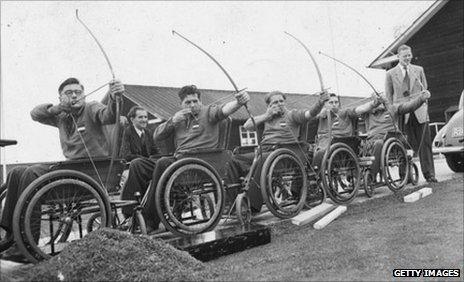London 2012: How Stoke Mandeville put Paralympics on the map
- Published

The Dutch wheelchair archery team practising for the 1953 Wheelchair Olympics
The Paralympic torch relay has put Stoke Mandeville on the map as part of its relay route, but the Buckinghamshire village has been famous for years as the birthplace of the Paralympic Games.
The Games were founded by pioneering neurologist Professor Sir Ludwig Guttmann at Stoke Mandeville hospital in 1948.
Sir Ludwig was born in Germany in 1899 and emigrated to Oxford in 1939 to flee the Nazi oppression of the Jewish community.
After working at an English military infirmary for head injuries, Sir Ludwig was asked by the government in 1943 to become head of the new National Spinal Injury Centre (NSIC) at the Ministry of Pensions Hospital at Stoke Mandeville.
The NSIC - now the oldest and one of the largest spinal injuries centres in the world - began as a treatment centre for World War II servicemen.
But Sir Ludwig came up with the revolutionary idea of using sport as a key part of rehabilitation - this, combined with his positive attitude towards patients, was the key to his success in treating them.
Until this point, people with spinal cord injuries often died within a year of sustaining the damage, having been given no hope of returning to their previous life.
Under his care, people were encouraged to try activities including wheelchair polo, wheelchair basketball and archery, which proved popular, as paraplegics could compete with able-bodied counterparts.
In 1948, Sir Ludwig organised a competition for 16 paralysed men and women - the Stoke Mandeville Games for wheelchair athletes - to coincide with the opening ceremony of London's 1948 Olympic Games. Their first competitive sport was archery.
Sir Ludwig's daughter, Eva Loeffler, who was a teenager when the first Games took place, recalled them as a happy event.
"There was a wonderful atmosphere at the Games and I recall there was always an enormous party in the sports hall on the final evening," she told Bucks County Council's Mandeville Legacy website.
"I used to run around with a tray handing out pints and pints of beer and everyone got very merry. I remember one year Margot Fonteyn the ballerina was there while her husband, who was a tetraplegic, was having treatment in the spinal injuries unit."
Four years later, competitors from the Netherlands joined in, sparking the beginnings of an international competition.
By 1960, a Games for athletes with a disability took place at the Rome Olympics and the modern Parallel Olympics - or Paralympics - were born.
Other disability groups were added at Toronto's 1976 Olympics, and in the same year, the first Paralympic Winter Games took place in Sweden.
Sir Ludwig continued his work at the hospital, where he was known by staff and patients as 'Poppa'. He remained a key figure for the Games, becoming president of the International Stoke Mandeville Games Federation.
In 1961 he founded the British Sports Association for the Disabled, became inaugural President of the International Medical Society of Paraplegia (now known as the International Spinal Cord Society) and edited the the society's journal, Paraplegia.
The Queen knighted him when he retired in 1966, having already made him an OBE and CBE.
The NSIC is still carrying on his work, having expanded from 26 beds to 190 in the main part of the hospital.
It has benefited from the fundraising activities of the late former BBC TV and radio presenter Sir Jimmy Savile, whose marathons and events over the years raised a total of £10m, fulfilling his aim of creating a purpose-built spinal cord injuries centre.
- Published16 September 2011
- Published15 September 2011
- Published9 September 2011
- Published23 May 2012